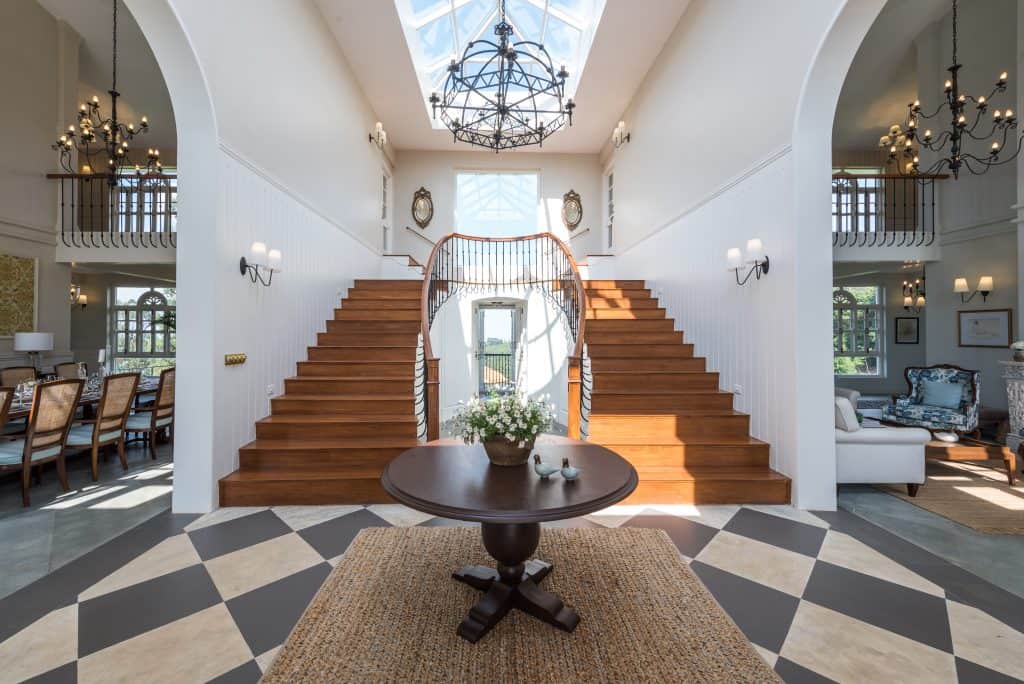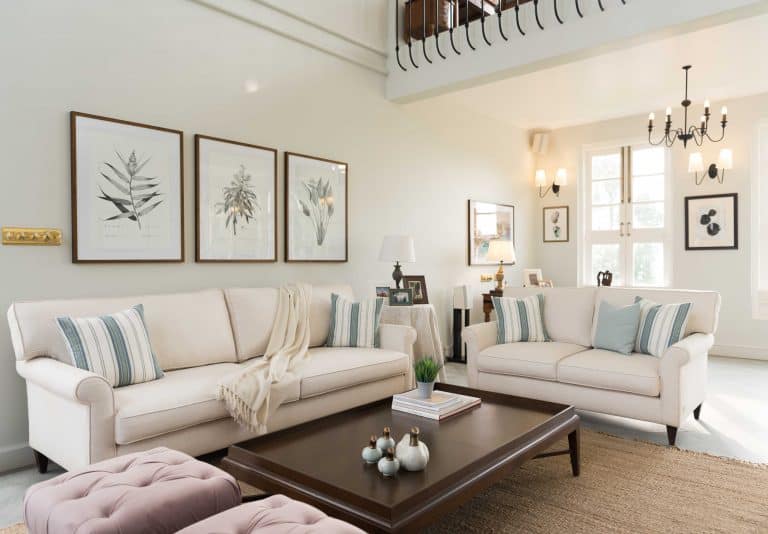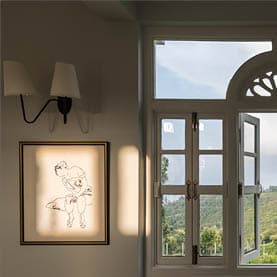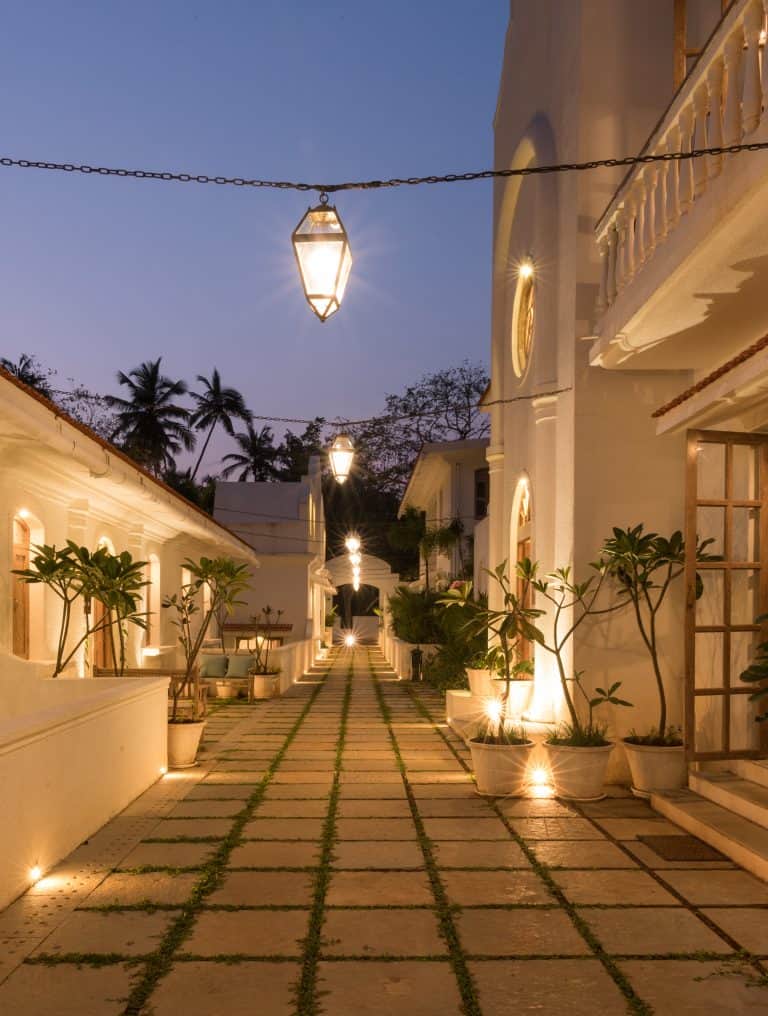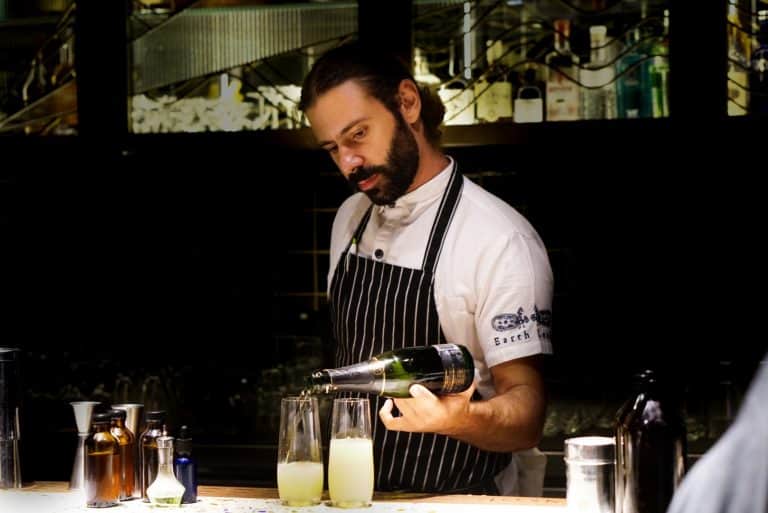Isprava’s first ever Estate in the hills – Welcome to Gleneagle Estate, Kotagiri
The allure of the Blue Mountains, the heady aroma of Eucalyptus trees and the charm of colonial luxury-Isprava’s Gleneagle Estate is Kotagiri’s newest treasure trove.
Far from the rigour of tourism, through meandering roads carved out of the mountains, atop a rolling hill and wrapped around by unending green slopes of perfectly trimmed tea bushes, sits the luxurious Gleneagle Estate. Whether you appreciate it for its neoclassical architecture or its flawless landscapes, its intricate detailed interiors or its exclusively curated antiques and artefacts, this country-style estate is quite a sight to behold. It is the kind that will stay etched in your memories long after you have left its luxe embrace.
Gleneagle Estate blends modern with classic and ensures the grandeur of the estate is perfectly juxtaposed with the bounty of nature that surrounds it. It borrows inspiration from old mansions of England, and promises the finest valley views from every single window. Each detail was carefully considered while bringing this masterpiece to life. Long staircases, double heighted spaces, sprawling living and dining rooms, bedrooms with cosy nooks and corners, carefully restored doors and stained glass windows, sparkling wooden floors sourced from Havelis and grey stone tiles, gardens peppered with beautiful flowers and vegetable patches–every inch of the estate has its own charm. Complementing the teak and mahogany tones of the house, you will find elegant velvet sofas, comfortable armchairs, silk tapestries mounted as backdrops, vintage paintings, baroque-inspired mirrors, marble fireplaces as well as an estate-worthy, 12-foot long dining table. Even the library is designed to astound–and it is our favourite respite to catch up on a novel over some hot tea with sunlight dancing in through its arched French windows. This is what we like to call true bliss.
And there you have it, our very first Estate. But definitely not the last.
Antique vs Abstract
If you are looking to give your home a fresh update, here is the low-down on two of the biggest decor and design trends. You can weigh your options or dive into the best of both worlds and make your home one of a kind, just like we do at Isprava.
Every interior designer knows that furniture and interior accents can make or break a space. Choosing the right pieces, maintaining a fine balance between trends, textures and colours is paramount. Both design forms have plenty to offer and have immense visual appeal in their own way. You can pick just one or juxtapose old with new, merge vintage and blend the muted with the bold… the choice is yours!
The allure of the abstract: Geometric patterns offer a loose, over scaled, asymmetrically shaped aesthetic and exude what we like to call the ‘perfectly imperfect’ vibe. It increases the drama quotient of any space with bolder colours and oversized patterns. You can go minimalistic by incorporating this trend only through accents like throw pillows and table runners, or you can go the whole nine yards and bring abstract art to life through angular furniture, flowing rugs, lighting, upholstery, tables and more. Just like the colourful mathematical puzzles you used to solve when you were young, these geometric designs will bring a retro atmosphere to your home. What about a Rubik’s cube-inspired cupboard or a carpet featuring a mesmerising mosaic pattern, or geometric wallpaper or even a mix-match of straight-lined patterns in furniture with round ones. All of this is bound to make quite the statement.
The antique connection: The irony of antiques being the way forward for the future of design is interesting but not surprising. People, including millennials, want their spaces to have soul, personality and a story to tell. And antiques do that the best! Whether it is through a set of old lamps, an ancient dining table, a vintage chandelier, or a clock on the mantel–from big statement pieces to more minimalistic displays, antiques invite the mind to imagine all kinds of personal histories. They can cover a broad range of time and can influence majorly. One that we particularly love is the Art Deco period that beautifully blends clean lines and curves with decorative elements that break up the starkness of modern lines. The best part of adding antiques to a space is that you can use it in the most unexpected ways and unexpected places. For instance, a bird bath as a wash basin in the bathroom, a chandelier in the balcony or pagoda, 18th century mirrors in the kitchen. You can do anything you want!
Vaddo for rent!
Calling all big groups, large families and friends who love holidaying together. Isprava has just the spot for you–Igreha Vaddo, Isprava’s first gated community.
Everyone dreams of having their own private island, even if it is just for one weekend. And maybe one day, Isprava can oblige (we hope). But for now we can offer you a private community with not one or two big villas, but five -all yours for as long as you would like to rent. Whether it is a pre-wedding celebration with close family, a bachelor’s party or just a chance to come out in groups of many –all roads lead to Isprava’s Igreha Vaddo, in Siolim, Goa. Here you can luxuriate amidst nature, family and friends, and let the good times keep rolling.
Located around the rare green fields of Siolim in Bardez, North Goa, Igreha Vaddo is away from the tourist bustle and is a perfect hideaway for big group celebrations. As soon as you arrive, you will be reminded of an old Portuguese village. The Vaddo comprises of six gorgeous villas, a common parking lot and is surrounded by trees and greenery on all four sides, promising privacy and beautiful views in equal proportions. Each of the villas are spread across two floors giving you about 16 + 3 bedrooms to rent out. They feature beautiful courtyard entrances and lush backyards with a private pool, double heighted spaces, aesthetically designed lobbies and foyers, bridges connecting each wing of the home, terrace-like garden balconies and so much more. Here, you will discover luxury, comfort and lavish spaces that unify contemporary style with classic design in perfect synchrony. The villas boast Goan architectural elements like mouldings, chhajjas and sills as well as modern glass roofs, garden balconies and beamless structures. They celebrate a timeless, neoclassical appeal with understated luxury and a muted colour palette. Inside you will fall in love with the antiques and it’s interior decor, making every nook and corner an Instagram-worthy click. So what are you waiting for? Gather the troops, make a big fat plan and book almost an entire community to yourselves! There is really nothing like it!
Greatness of Gourmet
Playing executive chef for India’s premier gourmet chocolate brand, Naviluna, Isprava chats with David Belo on his handcrafted, delicious and healthy pieces of luxury and about the journey that brought him here.
1) From a celebrated cocktail bartender around London to a luxury chocolate crafter here in India, tell us more…
You know I think its two things. The first being inspiration. After so many years, telling the stories of great wine Chateau’s and distilleries in far flung places from behind the bar in Soho and after meeting the likes of Don José Navarro (Head Distiller Havana Club), Desmond Payne (Head Distiller Beefeater Gin) and Jim Rutledge (former Head Distiller – Four Roses Bourbon) I really wanted to live out that story and become a producer. At the time, I was doing my own “life-style” audit and wanted to do something that had all the finesse of the wine and spirits world, but would give me some distance from it whilst transitioning to a yoga and wellness lifestyle. The second side to all of this was the pursuit of craftsmanship. By 2008, I felt I’d plateaued as a cocktail bartender and needed a new medium to keep pushing my skills and knowledge in food & beverage. I baked sourdough and pastry from 2009 – 2011, but when I discovered some cacao beans from Gokarna during a meeting with a friend in Mysore back in 2011, I had found my new medium.
2) You have not only created magic, but won accolades for it too. How would you define the words so often used in the Isprava vocabulary, like ‘artisanal’ and ‘luxury’?
Artisanal is a great word, but its meaning has been diluted through overuse and inappropriate application. For me, the pursuit of an artisanal approach to one’s craft means relying primarily on skill rather than technology. We of course use technology at NAVILUNA but only in places where manual work would be back breaking or inhumane. Instead of relying on Italian tempering machines, all our chocolates are tempered on cold marble slabs, the old fashioned way, and our chefs are trained in the complex science of cacao morphology. It is a simple process but very complex science, demanding both theoretical and experiential knowledge from the craftsmen. All our ingredients are hand selected, and diced, roasted, sautéed and candied by hand. Our chefs are trained to rely on their palate to determine when the chocolate mass has been properly refined. We use instruments of measure to confirm the results for the sake of consistency but our philosophy is to use the senses first and employ technology only for confirmation. This requires training and skill, that for me is what it is to be an Artisan.
Luxury is another overused word in my opinion, yet its true meaning reflects something beautiful. True luxury is contextual; it doesn’t just have to evoke Italian leather or a Rajasthani Palace. When you are camping or at a festival, a warm shower can be luxury. In fashion, the selection of well loomed fabrics can feel like luxury as much as the quality of the tailoring. I think true luxury is a mentality, a way of thinking about things. Luxury is the pursuit of excellence, a rejection of the mundane, surpassing the obvious and superseding standard practice. At NAVILUNA, we are dedicated to creating everyday luxury. We do not believe that luxury has to be relegated to special occasions.
3) If you had a hideaway home, what are five elements that must be a part of it? Any secret chocolate chambers?
Haha! Yes a chocolate library for sure! Framed by high Mangalore tiled ceilings with a sky light, Fela Kuti records on vinyl, a good collection of Italian Amaro & Vermouth (Antica formula is a firm favourite) and a humidor filled with Nicaraguan cigars by Garcia Garcia (Le Bijou 1922 is still my first choice). Who’s coming over for a visit?
4) How does nature inspire your work and creations? Tell us about your three favourite chocolates and the art of making true bliss?
I think the study of nature is the study of creation itself. When we engross ourselves in the pursuit of creativity, we are unwittingly taking part in creation and in nature by extension. In the same breath, I feel all great art mirrors nature and personally draws heavily from the canonised proportional thinking of classic Egypt and Hellenic Greece. You will notice that the ratio of cacao to sugar (coconut sugar) in all our base chocolate is 72% to 28%. 72 is the number that governs equal temperament tuning in music, the inner angle at the centre of a pentagon, which is the shape of the pentatonic scale. As the pentatonic scale has five musical notes, the taste spectrum has 5 flavours; sweet, sour, salt, bitter and umami.
When I designed our Mango Chilli & Red Capsicum bar, I was looking for an after-dinner bar that would make sense after a spicy meal. Knowing that umami and salty flavours would linger on the palate after the meal, I used red capsicum with its moderate umami and mild sweetness as a flavour bridge from the meal to the sweetness of the chocolate, whilst a hint of fresh vanilla offsets the salt, which heightens the sweetness of the tangy Andhra mango’s, all finished with a subtle hint of chilli to resonate with the flavours still lingering from the meal before. So as you can see 4 out of the 5 flavours on the taste spectrum are incorporated into the bar (sweet and sour from the mango, umami from the capsicum, bitterness and mild acidity/sourness from the chocolate) but the salt has to come from the meal. In this way, the experience of eating the bar after a meal mimics the natural law of 5 (5 platonic solids, 5 elements) that underpin all of biology in nature.


